When does a trip begin? Is it the 4 am pickup from the airport shuttle? When you check your bags at the airport? When you get on the plane? When it takes off? When it lands? These were a few of the questions in my mind as I tried to nap in the Denver airport. We’d just gotten the news – via text message, via the airport departure chart, via the little sign at the gate – that our 5 hour layover had been extended to about 7 hours.
The geniuses who design airport terminals have gone out of their way to make them difficult to sleep in – there are few “dead spaces” where you can just sneak off, and everything is designed to be uncomfortable to one who is trying to get comfortable. I’m not sure why they’ve done this… perhaps to avoid a litter of horizontal bodies taking up space? Perhaps to deter theft from snoozing travels? Or perhaps the same reason some little boys are cruel to small animals – just because.

People need to sleep. And sleepy people will find a way to do it. Perhaps someday, the halls of airports will be lined with couches… with little lockers underneath to stash your stuff… and outlets to charge-up your electronic detritus… and pillows… and blankets. Ok, maybe not. But until then, at least Denver does have an upstairs area with a lot of dead space. It’s uncomfortable dead space, populated with the same slightly-uncomfortable chairs you find near the gates – the chairs with the metal arm rests bolted into place. But, there was hard carpet… and I might have managed at least 36 minutes or so of restless dozing.
Real sleep was tough – I had a lot on my mind. This was to be a pretty straightforward trip – not unlike trips taken by countless others. But, this vacation was not going to be about relaxation. It takes a small pile of money to get to Costa Rica. We weren’t sure if or when we’d be back. So, we planned to make the most of our time there – zooming around to as much of the country as we could manage… yet trying to stay still in places long enough to get a sense of them. We’d planned this all ourselves; hundreds of little details and plans were floating around in my head. There was nobody else to ask if we got something wrong.
Time has a way of marching along… and soon enough, it was time to gather at our gate. I had a look at the people around us… all of them had for whatever reason decided to pick the same flight. Each had their own plans, ideas, apprehensions, experiences… As the gate staff asked us to look at our boarding passes, one middle-aged women with too many bags and pockets started leaking dollar bills onto the floor – one after another. It wasn’t clear where the cash was coming from, but all of us had a good chuckle as it was handed back to her while she spun around trying to find the source of the leak. “Not a great way to start a trip”, I commented to a fellow passenger.
I made the usual small-talk with my fellow passengers. One was going to assist a friend with a week-long adventure race along the Pacific coast. Another was part of a large group planning to help build a church. He’d been told to be clear he was not working, rather “volunteering”. Paid work involved whole other levels of paperwork and visas. As we approached San Jose in the darkness, glimmering yellow lights decorated the landscape below – not in any pattern, but just like a Christmas tree. A few of these were exceptionally bright – likely some kind of night-time work site. “Hey, I see a volcano”, my church-volunteer neighbor suggested, “check it out!”. I wanted to tell him that there weren’t any active volcanoes with flowing lava in Costa Rica… at least not right now. “Are you sure about that?”, I asked. He was. I let him go on believing – something he was good at. When it came time to fill-out the customs paperwork, it became clear he was not the brightest person “So, am I one person?”… It was probably good he was going on a pre-arranged trip, and staying in one place with a set goal to accomplish. He wasn’t even sure where in Costa Rica he was going, “I’m not sure, they all got it planned”, was his response to that query.
All of a sudden, we’d landed. We had our bags. We were through customs. We were on our own in another country… near midnight. It was a little abrupt and disorienting. Outside, the usual cacophony of taxi drivers and people with nothing better to do were there to greet us, harangue us, and try to absorb some of the money that western travelers tend to bleed. One of them insisted to call our hotel shuttle for me. Before I could say “what?” he put the equivalent of a dime in a payphone and handed it to me. It wasn’t necessary as the shuttle was already pulling up. “I work for tips”, he smiled… I didn’t have any money yet, and even if I had, there was no way I was giving this guy any. I just couldn’t figure out what the point was – this was really the best life-plan he could come up with?
The hotel was basic, close to the airport… and overpriced. But, the bed was comfortable. It had been a long, tiring day of sitting around while we were shuttled across the globe.

The next morning, I got up and started walking through the outskirts of Alajuela – the airport town next to San Jose… I had reserved a rental car at a location just a few blocks away. The neighborhood around the airport was a mix of tidy upscale hotels, run-down buildings, and crammed businesses and homes of all sorts. It was basically busy and functional – similar to a neighborhood you might encounter near any airport. I walked a mile or so under warm breezy skies, keenly aware that I wasn’t in Portland anymore.
Thankfully, the guy at the rental desk wasn’t too busy, and seemed to have my information. He spoke passable English – just about every business who regularly dealt with tourists did the same. After a lengthy process of being warned about all the dangers I might encounter (unless I bought the premium insurance, of course), I signed my life away on a ream of papers, and was introduced to my vehicle – a Mitsubishi L200.
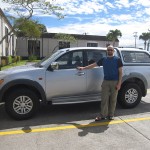
My guess is that Mitsubishi didn’t sell a lot of L200s… and they ended-up selling them cheap to low-end car rental places, like the one I was at. Never seen an L200? It’s a bit like a large Subaru Brat, but with a cab in the back – a kind of mish-mash Frankenstein creation that isn’t easily classifiable (and I learned later, somewhat popular in the UK). I’m not sure what Mitsubishi was thinking with this one. But, it worked, and it had 4-wheel-drive – which every guidebook and prognosticator said was a must-have for Costa Rican driving.
After an uneventful drive back to the hotel, we were soon packed-up and on our way. I’d heard all kinds of horror stories about the roads in Costa Rica – endless potholes, wheel-sucking mud, ruts, crumbling bits of asphalt… Right away, we hit some construction and were detoured onto a hilly frontage road that seemed more improvised than planned… in the middle of a thick stream of cars heading out of San Jose.
I’d also been thoroughly warned about the perils of navigating Costa Rica. But, we only had a few turns to make, and were headed to a popular tourist area. As it turns out, there indeed are road signs in Costa Rica. Intersections of the major highways had signs that showed the road numbers, and arrows pointing the way to the next major town. Secondary roads just had the signs indicating the next town. Smaller roads had no signs, but we didn’t have to take many of those.
The road improved, the traffic thinned-out, and we started to get a feel for the place. Maybe this was when the trip started? It was the first time we were able to relax and joke a bit. The car had only come with ¼ tank of gas, and soon we had to stop to fill-up. I was suddenly thrust into a situation where the proprietors did not speak English. Luckily, there wasn’t much to say. “Viente mil colones?” I asked – about $40 worth of gas…? The guy nodded. There was some confusion about paying before or after the fill-up (after), but hardly enough to mention. We picked-up a couple juicy drinks, and were soon on our way.
A couple hours later, past numerous nameless businesses, countless fruit stands and bus stops… we had no problem identifying our turn-off – the massive intersection next to a gas station. I braced for the bad crumbling road I knew was ahead… but… the road was fine, actually kind of nice – a winding paved country road through a mix of forest and ranchland, heading slowly uphill toward the town of Santa Elena. We passed through a couple small communities going about their day… Finally hitting the pavement’s end about halfway up. From there, the dirt/gravel road did get bumpy, but it had been recently graded, and wasn’t much different from a typical forest service road back home.
Another couple hours of listening to the buzzing of cicadas, admiring the mountain views, and dodging iguanas (who seemed to occupy the niche of roadside suicide critter like the squirrels back home), and we rolled uphill and into the mountain town of Santa Elena.
Santa Elena was a compact place; basically a triangle of roads crammed with everything a tourist needs. If not for the nearby Monteverde reserve and the other reserves bordering it, this would be a sleepy ranching town with a store and not much else. Instead, it was tourist-central; a mix of foreigners looking the part, and locals figuring out some way to make a living. We found our hotel with no problem – the Arco Iris.
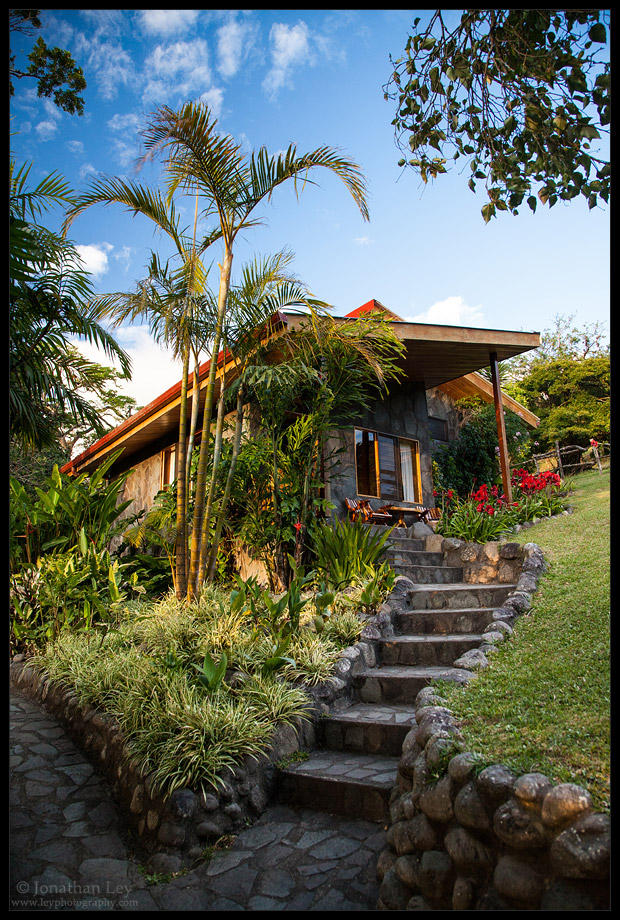
Arco Iris is Spanish for Rainbow. Like its namesake, this was a little slice of heaven; series of small, tidy cabins connected by stone paths that swung through lawns and gardens. Our cabin looked like something a real craftsman would be proud of – all wood and tile. Already we didn’t want to leave.
We didn’t have much of a day to do anything complicated – it was just a few hours until dusk. So, we took a stroll through the town, bought a few things at the grocery store… and decided to go visit the “Frog pond” just a short stroll out of town.
The Frog Pond was like a mini zoo, showcasing the frogs of Costa Rica. A concrete path wound past a series of enclosures each housing 1 or 2 species of colorful little amphibians. The entrance fee included a guide, who was essential. Even though the frogs were in enclosures, they were very difficult to locate – mostly sticking behind leaves, under blocks of wood and in other hard-to-see spots. In addition, even the most colorful frogs were thoroughly camouflaged when they weren’t moving. It seems nearly every guidebook or poster about Costa Rica has a Red-eyed Tree Frog on the cover. These are fantastic-looking creatures, with bulging red eyes & jet-black pupils, big orange feet, blue legs… But the ones we saw at the frog pond were all folded-up and resting. They looked more like a lump of green spit, and hardly noteworthy.
Our guide was sincerely excited about the frogs, the mission of the frog pond, and just everything in general. He peppered us with trivia about the different species and encouraged us to come back in the evening when the frogs were more active. This place was doing its best to be environmentally conscientious by not collecting more frogs, but instead breeding the ones they had. They seemed to be doing a pretty good job of things… the frogs had big spaces to be frogs, plenty to eat, and no worries.
So, we ate a relaxing dinner at one of the restaurants in town, and came back to the frog pond in the dark. We were handed a flashlight and sent into the darkness. The frogs were indeed more active, or at least more “stretched-out” – some stuck to the glass or leaves. The concrete path was absolutely dark. We had a chuckle how this same kind of operation would never fly in the US… there would be floor lights, legal disclaimers, signs warning of stepping off the path… But, we managed not to injure ourselves, and soon headed back to the hotel.

We awoke to what felt like our first real day in Costa Rica. We had no set schedule… though plenty of possibilities and plans. The first plan was breakfast at the hotel. Normally, this wouldn’t be noteworthy… perhaps some stale mini-bagles, jelly packets, a plastic cereal dispenser? No, this was a full spread of tropical hospitality – more kinds of fresh fruit than I could name, cheeses, fresh breads, yogurts… and little mini-omlets if you wished.
While we worked to discover our feast, a fellow guest approached the table next to us. She was a woman likely in her mid-sixties, and looked a bit unsteady, yet determined. “Are you going up to the reserve?” she asked. The other woman at the table squinted in confusion, quite obviously not an English speaker. The question was asked again – more slowly this time. The conversation stumbled along like this for a few minutes. I felt sorry for them both, it was painful. The gist was that the woman’s husband was staying at the hotel this day, and she was looking for a ride up to one of the nature reserves. She didn’t seem to have any clue how to deal with non-English speakers, wasn’t really sure where she need to go – neither the name or direction of the reserve – nor did she have any scruples about approaching anyone and everyone to solve her problem. She was persistent. She soon caught our gaze, and I cut to the chase – sure we could give her a ride. We weren’t going to that reserve but it was on our way (getting home would be her own problem). But, the hotel staff was on the case as well. A cab was called… the woman corralled. I shook my head… but in the end, the woman’s method paid-off; she got what she needed.
I wondered – are most tourists like that? Just stumbling around, treating everyone they meet like some bit character placed in their private dreamworld? Did the hotel staff think we were all like that? Just bumbling into things, uninformed? If so, what did they think we did back home? Our relative wealth must have seemed absurd – how in the world could such idiots be so rich? If I was a local, a few encounters like that would make me resentful and bitter. But, apparently they were better at this than me, or at least better at hiding it. They had to deal with this sort of thing all year long – every day. And they still treated each new arrival like they were the first people ever to visit.
A 20 minute drive down a bumpy dirt road got us to our first destination – the largest of the reserves, Monteverde itself. I was expecting a jammed parking lot and hordes of people. There were plenty of people, but very few vehicles. Most of the tourists seemed to heed the guidebook warnings to “not drive”, and took shuttles and taxis… which was all the better for us.
We paid our entrance fee, and turned-down the offer of a personal guide. “I guess you don’t want to see anything then”, the guy behind the counter said as he turned his gaze. I thought “jerk”, but what did I care, really? We just wanted to be on our own trip, and not led on a leash every step of the way. Yes, it was true that guides were very adept at picking out wildlife and pointing out all manner of trivia. But, that was OK. Sometimes, it’s nice to discover things yourself, on your own schedule – even if you miss a few things along the way.
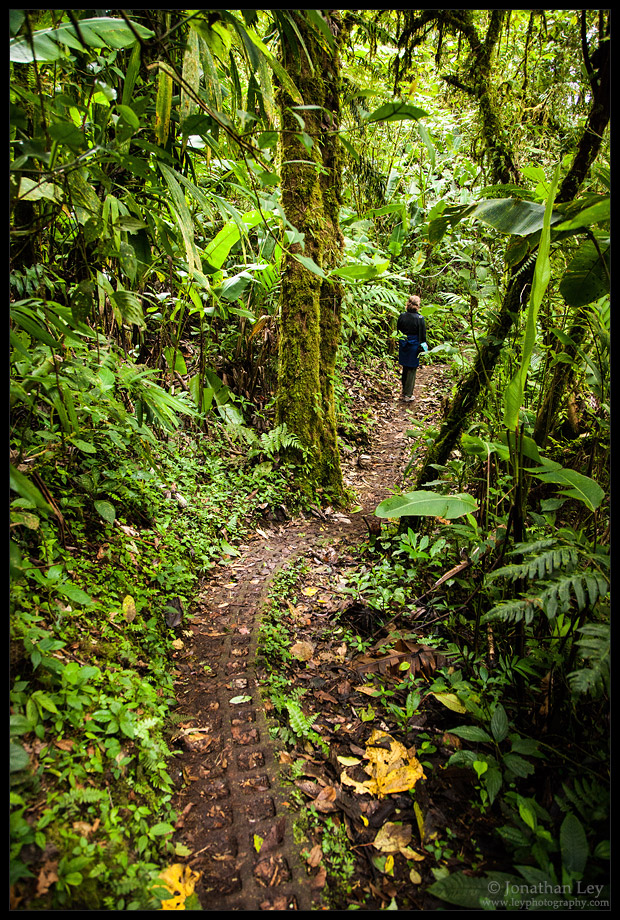
A minute down our chosen path, the people melted away. We were quickly enveloped by another world. Beneath our feet, a thin path sliced through an otherwise impenetrable morass of green. Fern were growing on mosses dripping from vines suspended by enormous pillars of wood. A thick canopy high above kept the sun a mere speckle. Everywhere we looked, something was growing – usually growing on something else. Most of the plants seemed to be epiphytes – rootless wonders suspended on whatever semi-solid surface they could find. Many of these air-plants were tiny, but some were huge – tangles of squid-like arms, floppy, spiny leaves, and otherworldly flowers. I thought that if an artist set out to design such a fanciful place, they couldn’t do nearly as thorough a job as nature had done by itself.
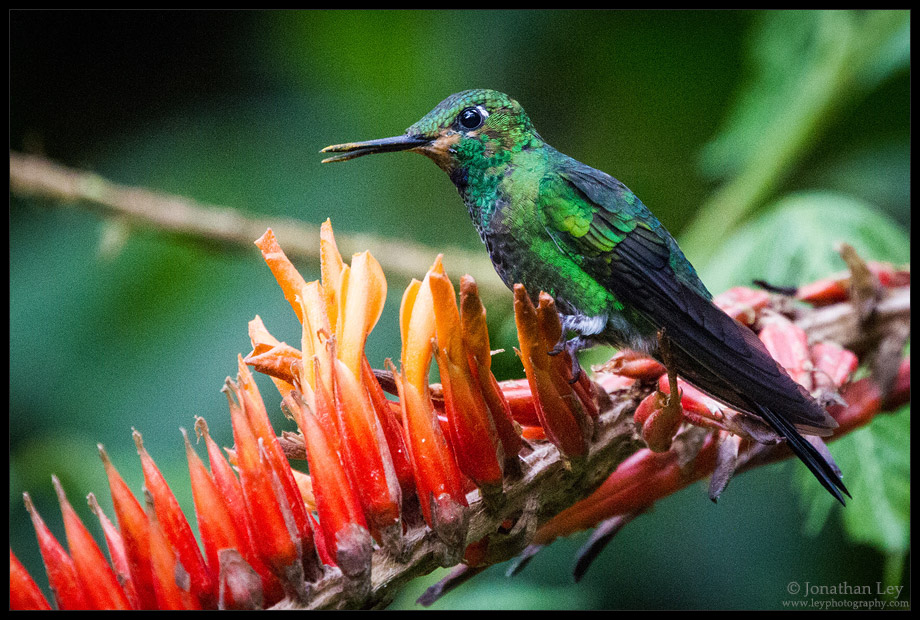
The birds were there – we could hear them… and catch fleeting glimpses as they darted through the green. Occasionally a wren or a hummingbird would pause on a branch or a flower, and we had a moment to admire these little jewels of the forest. I had a book that listed all the bird species in Costa Rica… a menagerie that was both daunting to make sense of, and wonderful to dream about. I had brought one luxury item with me – a big 400mm lens that looked like a futuristic armament, and instigated a lot of double-takes from passers-by (I convinced myself that most of them weren’t thinking I was crazy for carrying the lens, but instead jealous). In town, I had kept this thing tucked away in an unassuming pack. But, out on the trail, I had to be ready to snap away – I might only have a few moments to get the shot of a lifetime! So, I assumed the role of the “overburdened western gearhead”. It was just the price I had to pay.
We soon came to a hanging bridge. This cut across a short, steep ravine, and had the effect of bringing us into the mid-canopy. It was a brief little walk in the sky, but one worth lingering to consider. Up here, it was green in all directions. The forest truly revealed its 3 dimensions. For a moment, I could almost think of what it was like to be a bird – whisking through the vines and leaves to some familiar stump or branch, belting out a whistle or two, spying a tasty but, and zooming across a clearing to snatch it up.
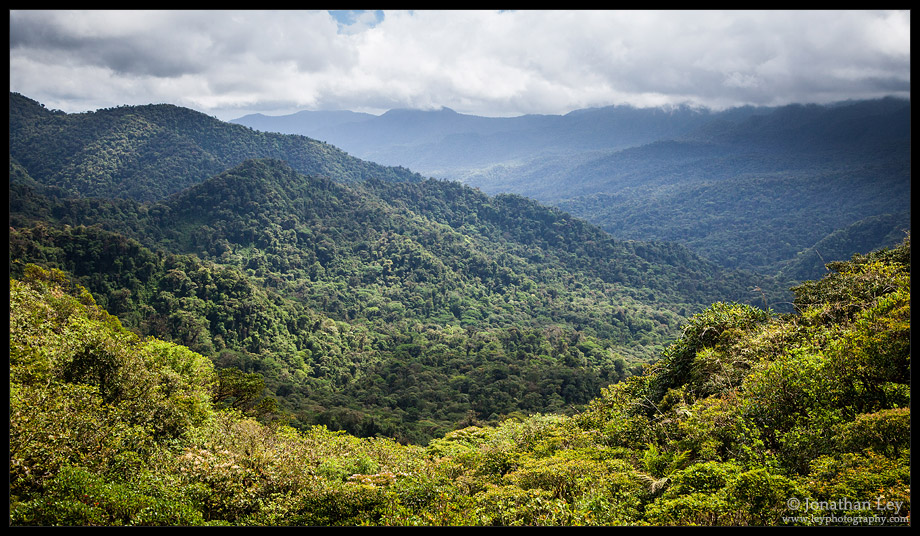
We weren’t exactly sure where all the people had gone. Perhaps the guided walks stuck to a network of trails closer to the trailhead? None of the trails in Monteverde were steep, nor very long. But we did slowly meander upwards and found ourselves at the furthest and highest point in the park – a small lookout on the top of a ridge. A few other people were taking breaks on a small wooden platform. We could see over rolling hillsides just like the one were were on. The view did seem encouraging in that we could see a lot of virgin forest. But, at the same time, it wasn’t that much. I realized that what we could see was just about all there was left.
We decided to take the long way back – a looping trail that framed the boundary of Monteverde. Even here, the trail was mostly in great shape. The reserve had planted cinder blocks sideways into the mud to help prevent erosion, cut-down on the mud, and provide traction to minimize “trail creep”… muddy trails have a way of expanding wider and wider as hikers look for dry footing along the edge of the trail. Ultimately, this turns a trail into a giant, ugly mud-pit devoid of any living plant. the cinder blocks worked wonderfully to prevent this – plus, they were relatively cheap and easy to install. I had to wonder if there was a place for something similar in some of the more popular trails back home.
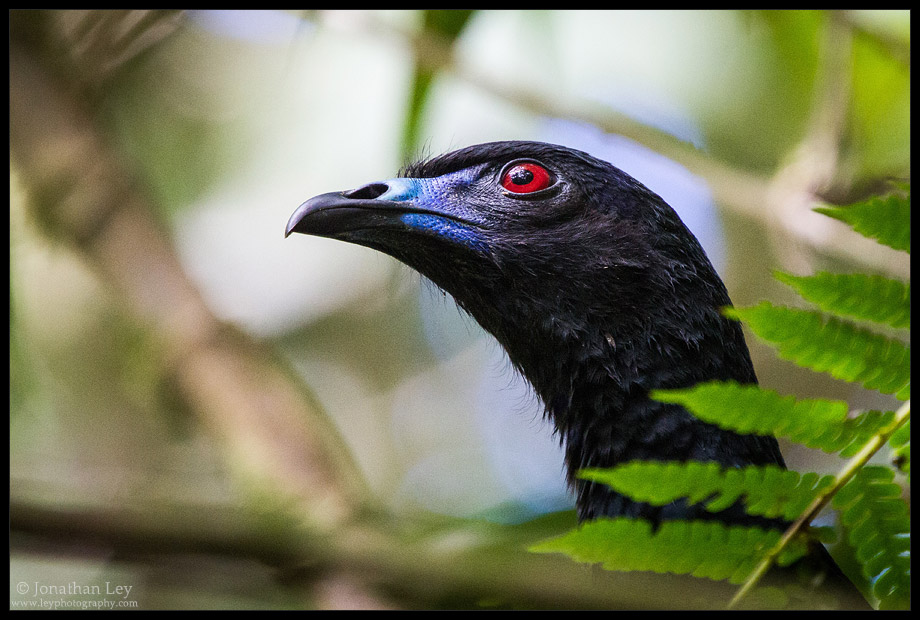
Along the way, were were entertained by chance encounters with forest denizens… A flash of blue appeared in silence to our side – a morpho butterfly. I had certainly seen and heard about morpho butterflies – going back to early in my life – but I had always just assumed they were rare, and didn’t expect to see one. But, here they were. Not just one chance encounter, but regular wanderers through the forest undergrowth. The morphos danced through the forest, never in a straight line, but always with determination to head a general direction. Next, a giant black bird dropped out of the sky and into the middle of a tree along side. It was a Black Guan. The bird seemed a bit bewildered by its circumstance. And as it regained its composure, I snapped a few shots. This time, my big camera proved too big for the task. All I could fit in the frame was the bird’s head.
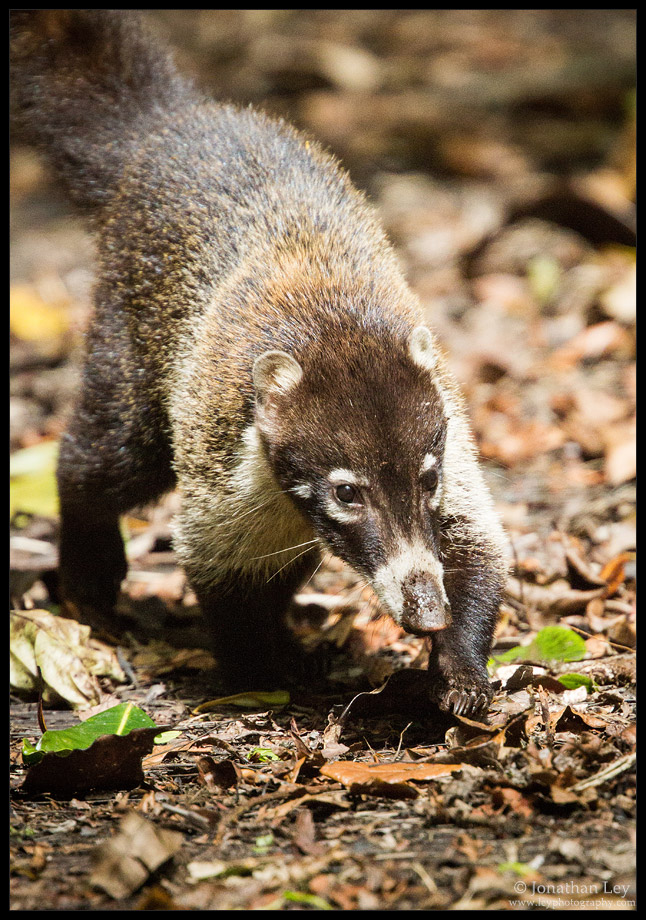
A little further along, I had stopped to try to get a shot of some distant birds in the canopy, when Nancy came back toward me on the trail “There’s…”, she paused, not finding the words, “… something.” She pointed up the trail, looking more confused than frightened, like she wasn’t sure exactly how to react to this indescribable event. “something is coming”, she finally concluded. She didn’t seem too concerned though… what was it – a clown on a pogo stick? Before I had time to consider the possibiltities, the interloper appeared. It was a small furry creature about the size of a raccoon, and similar in habits it seemed. Then, there was another, and another… a whole family of them – Coati – we later learned. They seemed completely unconcerned with us, even stopping to groom one another in what turned into a veritable orgy of licking and scratching. Soon enough, they melted back into the forest. A few feet off the trail and into the brush, and they simply disappeared without trace or sound. How many creatures had we passed within a footstep of, and not ever known?
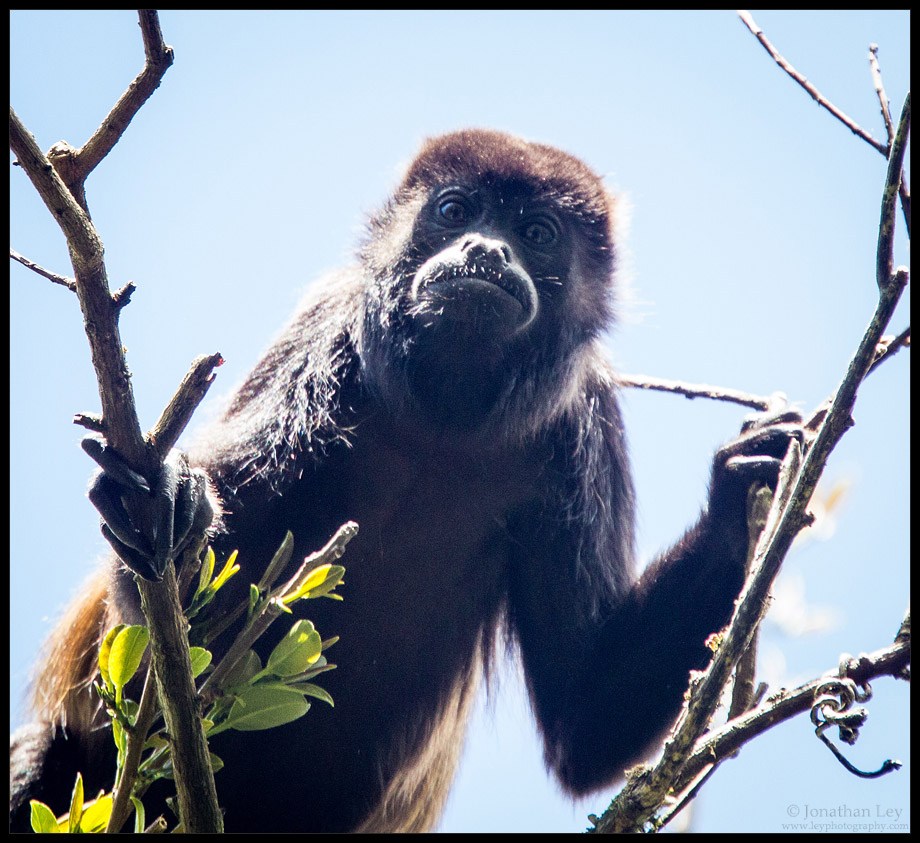
As we completed our loop, a few more people appeared. Occasionally, a group stopped on the trail – a guide had spotted something, set up a spotting scope, and everyone was taking a look. There was no monopoly on wildlife sightings, so naturally, one guide’s find was ours too. Someone had spotted a small group of Howler Monkeys in the treetops. They were quite a distance up – at the very top of the canopy, munching on fresh leaves. The people down below tried to find the best vantage point and watched them go about their business. There wasn’t a lot to see, but it was our first monkey sighting… another thing that once seemed fantasy was now just part of the everyday norm.
We got back to the trailhead in need of a long break. The cafeteria wasn’t especially appealing, but the juice was fresh, and the cafeteria food edible. A couple quick sandwiches and drinks had us a bit refreshed.
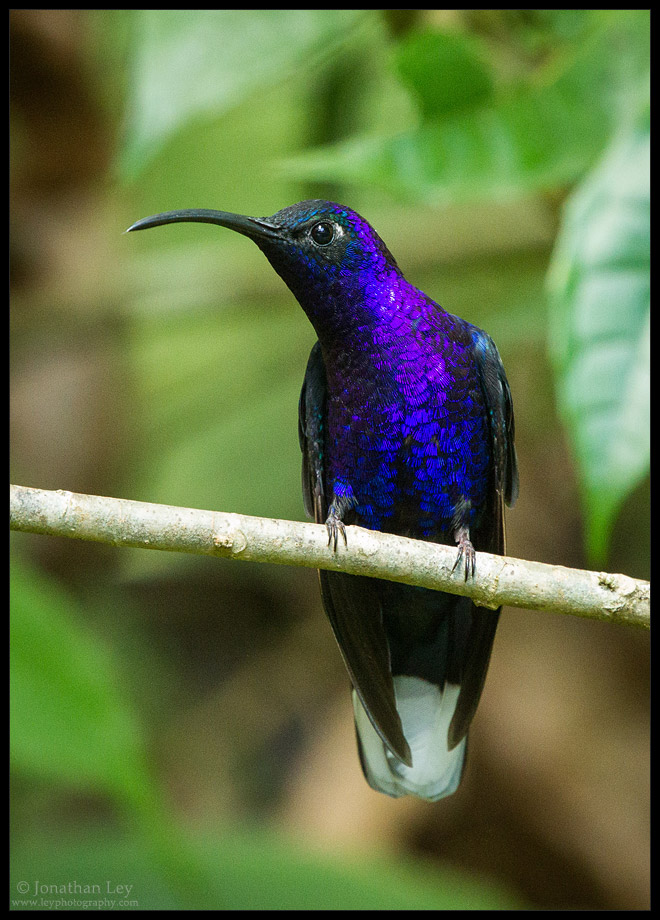
Just outside the cafeteria, near the trailhead, the Reserve maintained few hummingbird feeders. These proved irresistible to the little birds. They came from all points to converge on the endless supply of nectar. The air was literally buzzing with activity; tiny birds in iridescent feathers darted in a continuous stream, like little animated paintbrushes. Each of them were striking in their own ways – with long tails, colored stripes, and every shade of shimmering green, red and gold. But one stood out as king – the Violet Sabrewing. With curved bills, and a solid coat of sparkling violet, they were over twice the size of their nearest competitor. They were the most striking of the hummers, and also the nastiest – chasing away their neighbors like there were only a few drops of precious nectar remaining, and they wanted it all. Millions of years of evolution had made them feisty; a trait they didn’t need with such plentiful food, but one they simply couldn’t turn off.
Monteverde Reserve was created by a mix of american Quakers and other conservationists in 1972. The Quakers had come to Costa Rica as pacifists during the Korean War, and settled in the area. After a decade or so, it became clear that what little forest remained on the mountaintops was a unique treasure… and was quickly disappearing. Over time, more land nearby was protected as additional reserves, and the area became a draw for tourists looking to experience the rich beauty of the cloud forests. Even recently, a few landowners adjacent to Monteverde have joined the cause – partly because it’s good business, and partly because it matters… One of the newer reserves was called Curi-Cancha, on land just to the west of Monteverde. It was early afternoon, and we figured we still had enough time and energy for one more reserve, so we headed up the rambling road to Curi-Cancha.
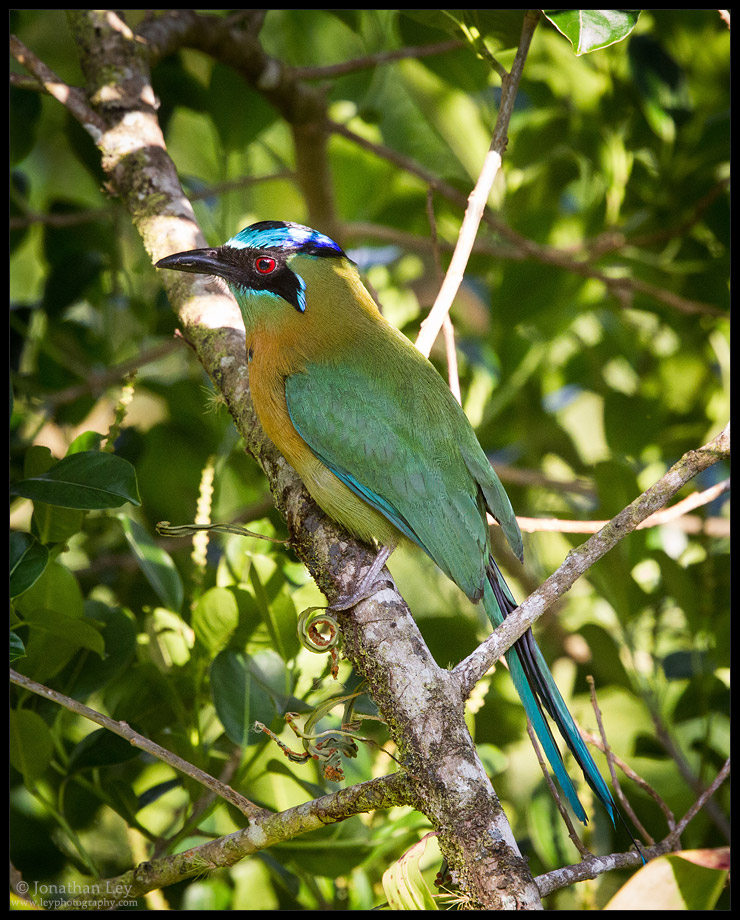
The first thing we saw was a sign that said “Closed”. There were no other cars in the lot. We considered turning around, but thought this was a bit strange. So, I got out and investigated the little ticket booth next to the parking lot. Sure enough, a woman was inside. She didn’t speak any English, but I was able to figure out that the “Closed” sign simply meant that you couldn’t drive on the road past the ticket booth. I wondered how many foreigners had seen that sign, and turned around. I wanted to give them some advice – perhaps change the sign to “no vehicles beyond this point”, and add a sign that said “Welcome to Curi-Cancha”… perhaps a trailhead sign with a map and other essential info? Well, we couldn’t complain too much – we had the place to ourselves. The park was closing in a couple hours, but it was enough time for a quick exploration.
I didn’t even make it out of the parking lot when I was distracted by the sighting of a Blue-crowned Motmot. This was a colorful bird, about the size of a large blue jay, with an olive-green back, and an aqua-blue crown. I explained my excitement to the woman at the ticket booth, but she just chuckled a little and explained they called them Bobos. I had the realization that these birds were only exotic to me. To the locals, they were just “regular birds”, still pretty perhaps, but not worth a celebration.
We wandered up the path and soon came to a bit of a pasture, where some hummingbird feeders were hung… and well-visited by the same assortment of colorful hummers we’d seen at Monteverde. A few other trails led up the side of the mountain, a bit steeper than Monteverde, but not too much effort. The forest here seemed a bit smaller and thinner than Monteverde, and the understory not quite as thick. I had to wonder if it was mostly second growth – not the same as the primary forests of Monteverde. Regardless, it was still beautiful, and there were still plenty of huge old trees, ferns, vines, and all the rest. The place did have a nice peaceful, inviting vibe. And the setup with the centrally-located meadow was interesting.
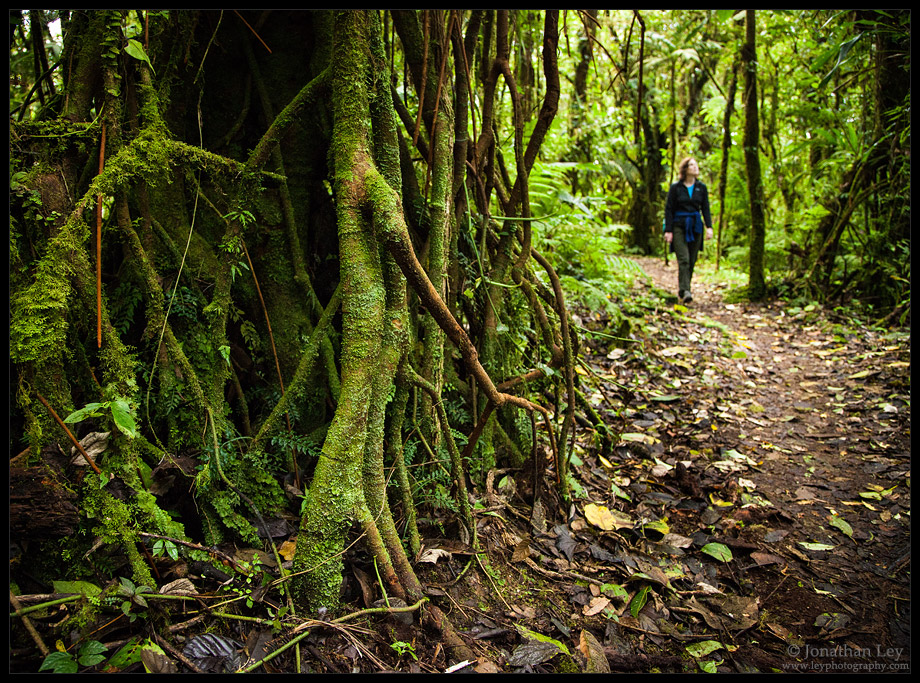
On the way back down, a group of European tourists had taken-over the meadow, so we headed down another path that skirted the edge of the reserve. Over the fence we could see what all this land would look like without any protection. It was mostly pastures with small clumps of trees. It was still pretty, but I thought about all the rich diversity of the forest in Monteverde – all of that was absent in the pasture lands. It was a bit scary to contemplate – that all this was nearly lost. Perhaps if the Korean war hadn’t happened, the Quakers wouldn’t have come, and all of Monteverde would have been mowed-over by the insatiable appetite of “progress”. The world was connected in ways we could scarcely piece together.
Back in Santa Elena, we cleaned-up and headed to a local restaurant. The food was fine – not great, not bad – but we didn’t have any particular standards. We were just happy to have spent a wonderfully rich day in this place so far from home.

The next day started much like the previous one – with a wonderful breakfast spread back at the Arco Iris. It was our last day in the area. We were reluctant to leave, but excited for the adventures to come. We decided to spend the morning exploring the second-largest reserve in the area, the Santa Elena Reserve. This also bordered Monteverde, but the entrance was around the back way, seemingly in the other direction. A few miles up a bumpy dirt road, and we were there. We had heard that Santa Elena could be crowded, and it was always best to get an early start. But, we arrived to a virtually empty parking lot. A couple of tourists were starting a guided tour, but other than that, we had the place to ourselves. We had thought about hiring a guide this time out… just to see what they could see. But, there weren’t any around, and the person at the ticket booth didn’t mention it. Oh well… we were on our own again.
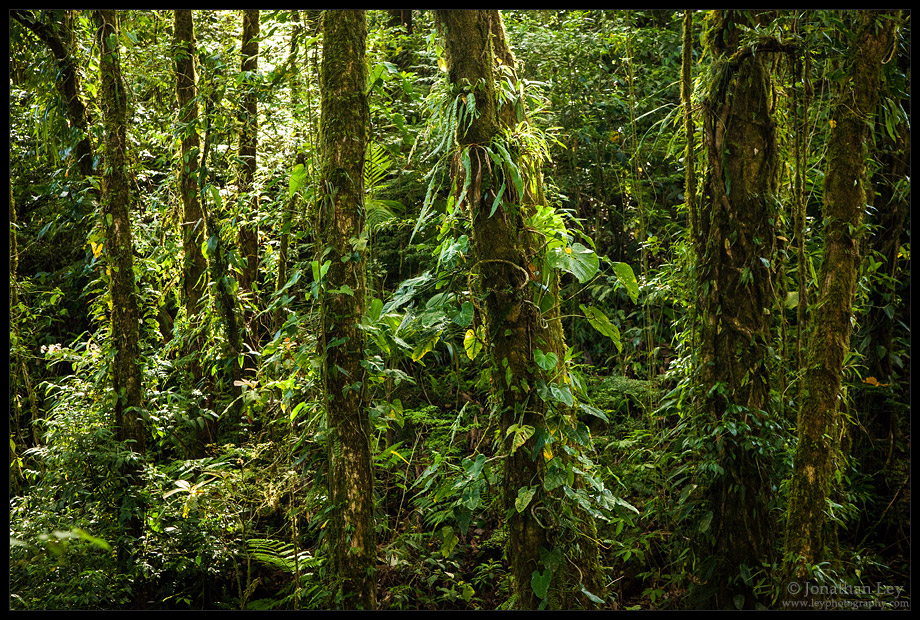
The forest of Santa Elena was every bit as lush and pristine as Monteverde. The trails were just as nice – with the same liberal use of cinder-block footings. There was a bit more up-and-down to the trails, but not really that much. Geographically, Santa Elena Reserve was on the Atlantic side of the continental divide, while Monteverde was on the Pacific side. But, it made little difference to the climate or anything else. It was another sunny day. Most people would be happy for the warm sun, but the concept of a cloud forest includes… well, clouds. Misty clouds would have added a bit of atmosphere to the place, and certainly made photography a lot easier (high-contrast sun-dappled forests generally look horrible in photos). But, we looked on the bright side – at least it wasn’t raining.
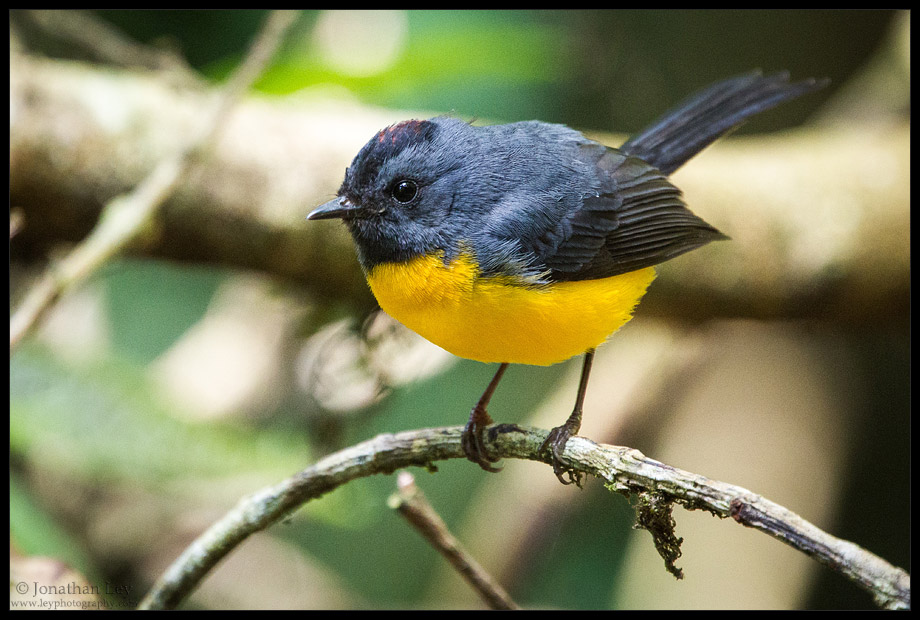
We spent a couple hours hiking a rambling loop of a few miles. Our route took us past a lookout tower (with views over the surrounding hills), and down across a number of muddy creek beds (crossed by short bridges). Through it all, we only saw one other person – a solo woman hiker. Where was everybody? I thought back on some of the guidebooks we’d read before setting out. They made everything seem so complicated – with a zillion choices and warnings. I wondered if in some weird way, guidebooks scared some people out of doing these things. When you read and read and read about a place, some people get more and more excited to be there. Others pick-up on each potential problem, and talk themselves out of it. Is that what happened here? Or were we just visiting on a slow day? We were happy for the solitude, but I hoped that many others would get to experience the wonder of this place.
When we arrived back at the entrance, we met a couple of Americans who were just arriving. They’d spent the past couple hours at another reserve just up the road. We’d passed by it on the way to Santa Elena, and heard about it as well. The reserve boasted a series of “skywalks” that all told added up to almost 2km of walking up in the canopy. The place also advertised zip-lines and a gondola ride… not exactly the kind of place that would seem to have an abundance of nature or wildlife, but we still had a couple hours, and after considering that we weren’t likely to get another chance, decided to check it out.
The entrance to this reserve was a bit more up-scale. It looked more like a golf club pro-shop than a nature reserve – with big glass sliding doors, and an overly-polished tile floor – even a restaurant/bar upstairs. They tried selling us the upgrade package – zip-lines & gondolas, but we just got a ticket to walk.
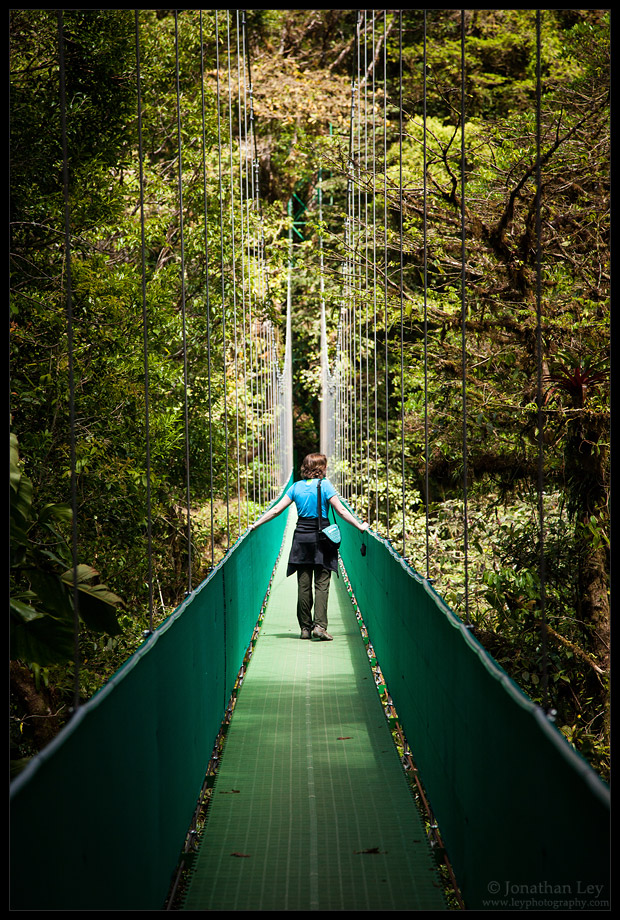
The trails were nice, and the bridges were impressive. But, we were here in the middle of the afternoon on a sunny day… I imagined walking across some of these bridges in a thick fog – not being able to see the other end, and getting lost in a warm moist world of clouds. Instead, it was unremarkably pleasant – no drama & little wildlife. Despite that, it was still worth seeing.
The restaurant, on the other hand, was not worth eating at. We got what the Costa Ricans un-ironically call “Typical Food”. And that’s a pretty good description – it’s what people typically eat, and not worthy of any more colorful moniker. Rice and beans… if you’re lucky, with a slab of meat (mine came with rubberized chicken). Costa Rica had so much going for it… but it was too bad there wasn’t a rich culinary tradition to match. I guess you can’t have everything.
Then, it was time to go. Back down the rambling road, back to check-out of the Arco Iris, back through the town of Santa Elena, and down down down the hill. Along the way we stopped for 30 minutes at a construction site where we watched a portly man in an orange vest devour an entire sandwich – start to finish. Further into the lowlands, we came upon a tourist bus that had pulled to the side of the road to watch a troop of Howler Monkeys in a nearby tree. We’d just been to one of the most splendid and pristine areas of Costa Rica, but here along the side of the road, in a tree on a ranch… the monkeys were a lot easier to see.
We were racing to get back to San Jose before dark. We didn’t have any hotel reservation, so were planning to “wing it” a bit – we did have a few potential places to check out. Though, the construction delay meant that we were going to be short on time. I still had to return the car… and the logistics of exactly what came next weren’t straightforward – this would be even harder in the dark. We were thinking about this when… TOUCAN!!! A toucan zipped past our windshield. It was about the quickest bird sighting I’d ever witnessed, but you didn’t need more than an instant to recognize a toucan. Sometimes, the most unexpected sights are the neatest.
We arrived back at Alajuela at dusk… and right in the middle of rush hour. We initially had planned to look at an old hotel in the heart of Alajuela, but bagged that plan when we were stuck behind a sea of red brake lights leading all the way into town. Instead, we headed straight for the car rental place. There were a couple of what appeared to be cheap hotels next to it – they’d have to do. The car return went without a hitch, and the cheap hotel next door worked well enough.
The manager of the hotel suggested we could get some takeout food from “Rostipollo” – a chain restaurant famous for their rotisserie chicken. I placed an order over the phone, and waited in front of the hotel for the delivery. Sitting next to me was an older man who worked in some facility for the hotel. He didn’t speak a word of English. So, I decided to try-out one of my gizmos – an translator app that I’d downloaded to my cell phone. Just speak into the phone, and it spat back Spanish… or at least close enough to Spanish. I learned the man had two very young kids, and seemed to take pride in his virility (he was likely pushing 60). He marveled this bit of technology that inched us closer together. I showed him on the map where I was from, “Aqui – Portland”. It wasn’t a perfect conversation, but it was something. Technology today usually serves to isolate and insulate us from society, but here was at least one instance where it did the opposite.

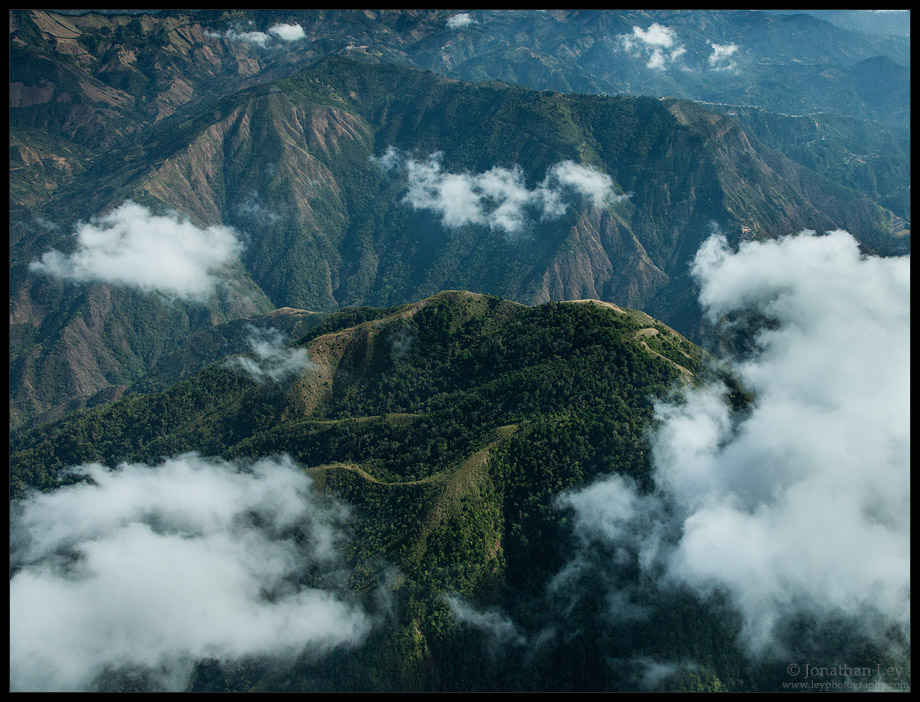
We had an early start the next morning – a 5 minute ride to the airport and onward to the terminal for Sansa Air. Sansa was one of two small airlines running shuttle flights throughout the country (the other being Nature Air). The process was pretty simple – get weighed, get your ticket, board the little plane, and hope for a smooth ride. There were only 2 other passengers in our plane, which could hold about 16. We rose up quickly above Alajuela and San Jose, then southward past great views of lush green mountains covered in ranches and forests. Then, we headed down the Pacific coast and through the building clouds. We were interested to notice we had a female co-pilot, who did much of the flying. In this macho culture, jobs like this weren’t commonly held by women. It was nice to see some strides being made. The ride was remarkably smooth, and in only 45 minutes we touched down at our destination – Puerto Jimenez.
Puerto Jimenez was a gritty ramshackle outpost in the southwest of Costa Rica – the gateway to the Osa Peninsula, our destination. We were met at the gate by our taxi driver, Dennis, who’d be our guide and companion for the next 2 hours – to the end of the road at Carate Beach. Dennis’s job was only to drive the vehicle (a mid-sized red Jeep), but he clearly loved his home, and relished the opportunity to show-off its many wonders. He did this drive regularly, and perhaps the hunt for wildlife kept the drive more interesting – a bit of a treasure hunt, a little different each time. His first stop was along an unassuming bit of ranchland with some trees along the road. “Pajaro”, he said, as he pointed to the tree. There was a bird somewhere in the tree, but I could see nothing. He was determined to share this, and got out of the car, walking half-way up to the tree and pointing… after some bit of effort, I could see it – a Lesser Nighthawk snuggled down on the end of a twisting branch. The bird’s feathers matched the pattern of the wood perfectly. It was nearly invisible even when looking right at it – it just looked like a lump on the tree. This was a nocturnal bird, and was essentially sleeping-off the day in this spot. How Dennis spotted it still amazes me, I was jealous of his skills.
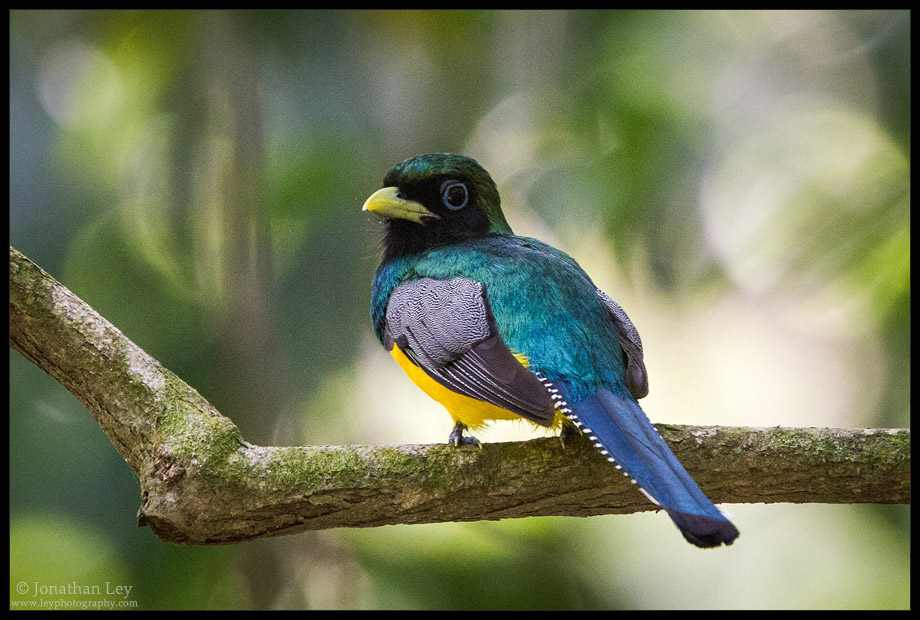
The rest of the drive continued much in the same vein. Dennis would see something or hear something, stop the car, and we’d get out to have a look. He heard a quiet whistle out the open window, and looked particularly excited. A few minutes of scanning the branches, and he pointed out “Trogon… see?”. A pair of Black-throated Trogons were perched nearby, softly tweeting to each other. The striking mid-sized birds seemed they had nothing better to do, but just model their plumage for human interlopers. By this point, I’d pulled-out my big lens, and managed to snag a few photos. Next up, a high-pitched squeaking, and the quick identification, “Squirrel Monkeys”. It took a little searching through the trees, but soon we saw them, a whole troop of Costa Rica’s smallest monkey streaming through the branches. Not much farther along, I managed a sighting of my own, “look, up there”, it was a pair of Spider Monkeys. Dennis was mildly impressed with my progress.
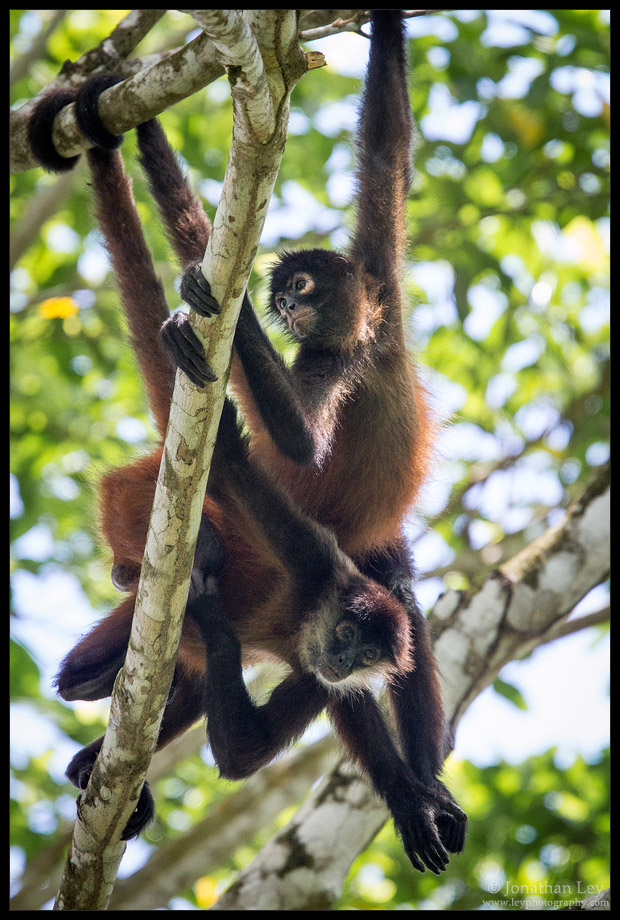
The road continued through a mix of mostly secondary forest, and ranchlands. All along the way, the constant buzz of cicadas permeated the air. The heat and humidity was palpable, and made the air dense. It had rained the previous evening, but was now a mix of sun and high clouds. We had heard this was “the worst road in Costa Rica” (a distinction levied on many similar roads), but we found it to be pretty tame. Sure, there were bumps, and a few stream crossings… but the road was regularly traveled, and graded. It was the dry season, so the streams were low, and easy to drive through (in the rainy season of September-October, some could be impassible). Dennis pointed out a pile of steel beams and concrete blocks near one of the streams. “They’re supposed to build a bridge here”, he explained. “That stuff has been sitting there for 2 years”… It was “Tico time” to the extreme. Native Costa Ricans were called Ticos, and time tended to stretch toward infinity as the complexity of a task increased.
A steady stream of other travelers passed by along the road. Some were locals, some walking, some on bikes, or even horseback. There was the local bus – the Collectivo – a beat-up old flatbed truck modified with seats & standing room in the back. Some were other taxis like ours, with passengers headed to various destinations along the way – resorts and beaches mostly. We passed one man on a motorcycle with license plates from Texas. He’d handed his bags off to a vehicle and was waiting for them to catch up. “I couldn’t cross those streams with all that stuff on my bike”, he explained. Another car flagged us down. A frustrated american holding a map asked, “Do you know where the turn is to Matapalo?”. Even I knew that he’d overshot that by a long way… “back 45 minutes or so?”, I told him. He had a hard time believing it, but I couldn’t figure out how he could have gotten this misplaced. His companions seemed frustrated, but I didn’t get that either – this road was a wondrous thing… filled with all kinds of interesting sights and sounds. In a place like this, the trip is everywhere you happen to be, and taking a wrong turn can sometimes be the best route.
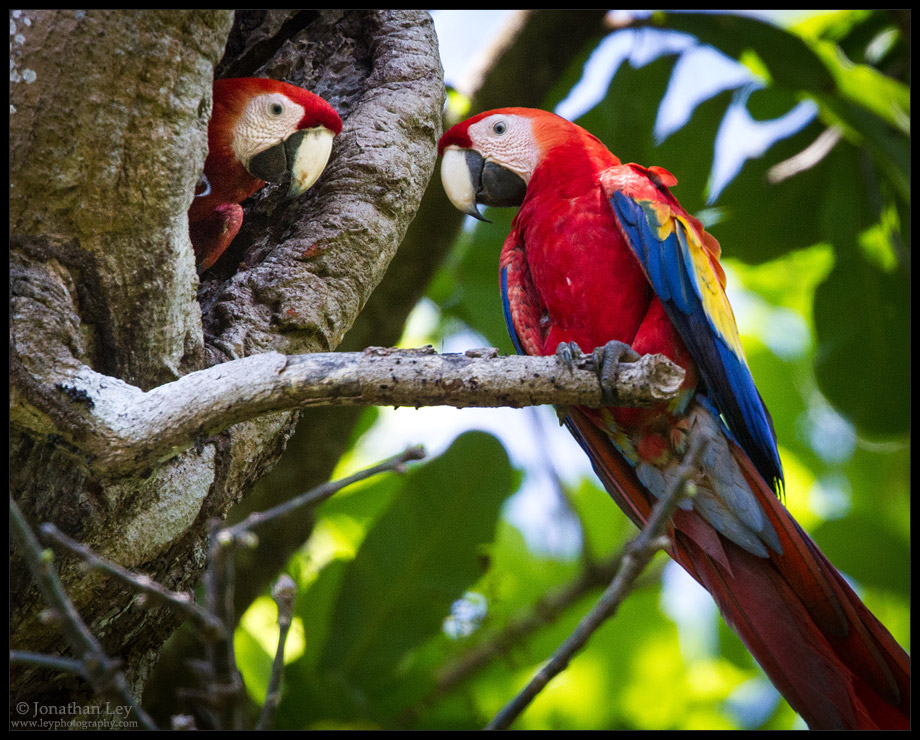
Our tour continued as the forest took on a deeper old character. We were passing through more stands of primary forest with larger trees, thick vines, and a tangle of undergrowth below. The cicadas got louder and continuous. The road narrowed… Dennis spotted a Tiger Heron during one of the stream crossings. A little while later, he stopped the car, and motioned for us to look up. Near the top of an old dead tree was a fantastic sight – a couple of Scarlet Macaws had a nesting hole. These were easily the most spectacular and recognizable birds in all of Costa Rica. If a child was asked to fingerpaint an imaginary bird, they could likely do no better than the red, gold and blue splotches on these magnificent birds. The powerful beak, and long pointed tails put them over the top on the fantasy scale. One of them was on the branch; the other crawled out the hole as we took a peek.
Nearing the end of the road, we pulled into a short driveway. Dennis parked the car, and we were greeted by a thin young English woman with long blond hair and a face that seemed locked in a perpetual grin of joy. “Welcome to the jungle” was the first thing Phoebe said to us; a perfect and appropriate start to our stay at Finca Exotica.
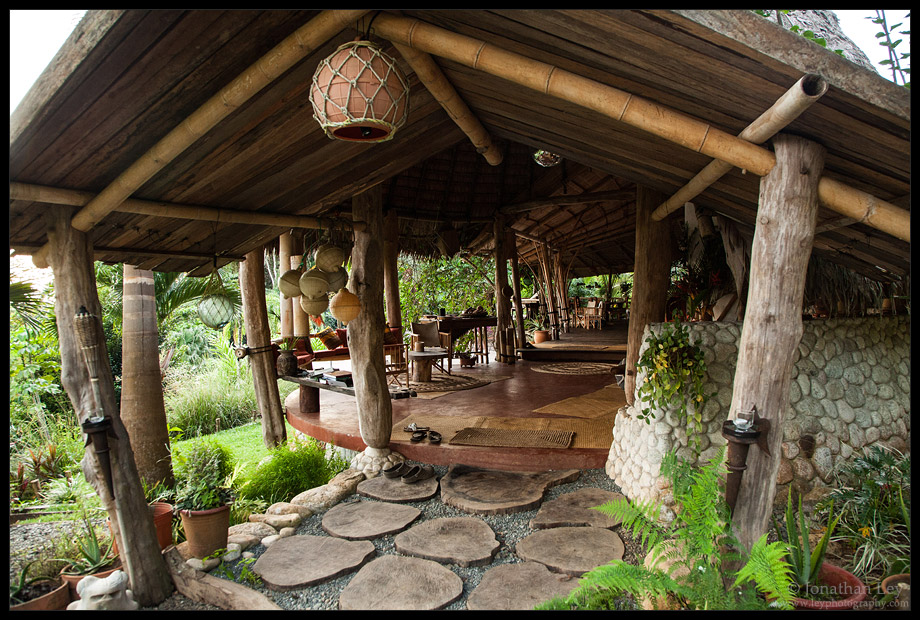
She led us along a simple trail past a small beach house with hammocks and fresh fruit laying about, over a creek popular with some small basilisks (lizards that had the name “Jesus Christ Lizards”, as they could run across water when startled), and up through what amounted to a jungle orchard with all manner of fruit trees; bananas, mangos, starfruit… dozens of varieties, each competing to be the tastiest. We then came to the main lodge; the hub of Finca Exotica. This was essentially a covered lounge that opened onto a huge deck overlooking the orchards at mid-canopy. Palm trees poked through the flooring to provide a shade. Continuing on was a small kitchen, and a long communal table. The structure was an inventive marvel of bamboo supports and thatched roofing; the quality and creativity of the construction was evident in every detail. Hammocks, couches and deck chairs were scattered around… Fresh squeezed juice was available by the gallon – more than we could ever hope to drink. The heavy drone of cicadas was ever-present, and the ocean rumbled in the distance below us. It was about as close to paradise as one could imagine.

The rest of Finca Exotica was a collection of independent cabins and tents connected by a series of pathways. After a short bit of soaking-in the scene, we were handed-off to Markus – the man responsible for all this. Markus had bought what was previously a run-down ranch/outpost, and created this place from scratch. He was German, but had been raised in Mexico. He was educated as an architect, but had experience as a cook, a DJ, and who knows what else. A better script couldn’t have been written – he was the perfect man for the place and the time, and drawn exactly as one might expect – rugged, individualistic, confident and sharp… with a tinge of cockiness and a dry sense of humor that fit him like a glove. He led us up an old road to our cabin, probably 50ft in elevation above the lodge.
This was a simple place, no more than we needed; a bed, some shelves, a couple chairs, candles… and a view extending from a mango tree within our touch, to a jungle hillside, and out to the bright blue ocean. The structure was open to the air, but surprisingly there were few bugs – at least few of the type that bit people. There was mosquito netting available. “I’ve never had to use it”, Markus explained. His place was just a bit further up the road, and from what we gathered, a larger version of the cabins. A little bathroom with a flush toilet & sink was steps away, and an open-air shower just around the corner. We plunked down on the bed for a moment, and relished the moment.
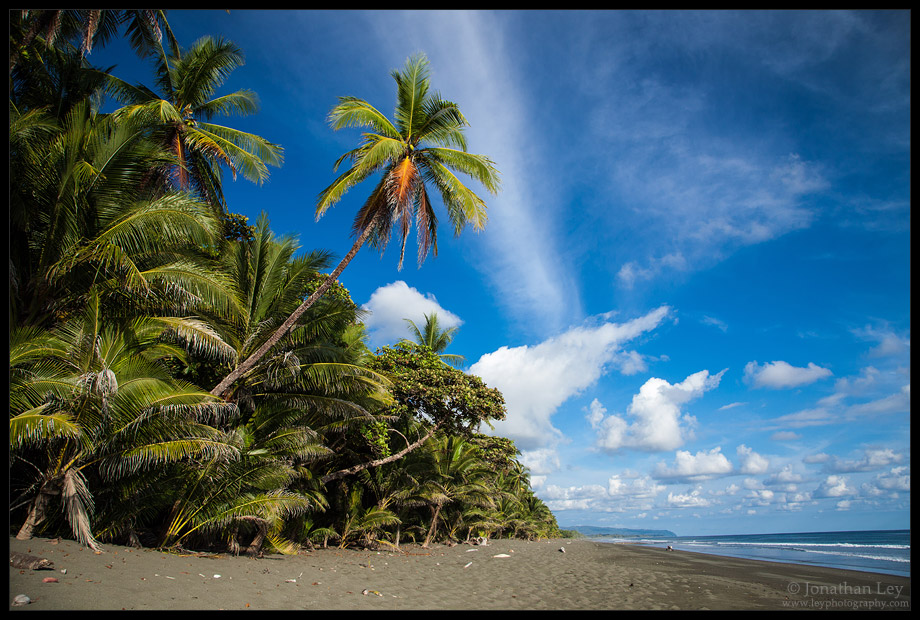
We had an afternoon to enjoy, and a new place to discover. After a brief rest, we stopped back down at the lodge, then continued back down to the beach. This was the kind of jungle beach that people dream of – wide, long clean sand, manageable warm waves, and empty. As far as we could see in either direction, maybe 1 or 2 people in the distance. The water provided just enough relief from the mid-day sun; just a tad cooler than the air, and a tad wetter than the pervasive humidity. After a bit of splashing about, we decided to take a walk and see what was to be seen.
The edge of the beach was mostly palm trees that quickly yielded to thick jungle.